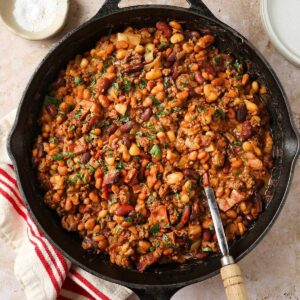Seafood pasta is a beloved dish found in coastal cuisines around the world, especially in Italian and Mediterranean kitchens. It’s cherished for its harmony of ocean-fresh seafood, aromatic herbs, and comforting pasta—all tied together with a luscious sauce. Whether it’s served at a seaside trattoria or in your own kitchen, seafood pasta offers a satisfying blend of texture, flavor, and culinary elegance.
What makes this dish special is the balance: the sweetness of shrimp and scallops, the briny richness of mussels or clams, and the umami depth of garlic, wine, and herbs. This guide will walk you through every step to create a stunning seafood pasta at home.
Ingredients
Seafood Selection:
-
200g shrimp, peeled and deveined
-
150g scallops (or calamari rings)
-
200g mussels or clams, scrubbed and cleaned
-
Optional: 100g crab meat or firm white fish chunks
Pasta & Sauce:



-
300g spaghetti or linguine (can use gluten-free if needed)
-
4 tbsp olive oil
-
3 cloves garlic, minced
-
1 small onion, finely chopped
-
1 tsp red pepper flakes (adjust to taste)
-
1/2 cup dry white wine (or seafood broth for non-alcoholic)
-
2 large tomatoes, chopped (or 1 cup cherry tomatoes halved)
-
1/2 cup heavy cream or coconut cream (for creamy version)
-
Salt and freshly ground black pepper to taste
-
2 tbsp chopped fresh parsley
-
Zest of 1 lemon
Substitutions:
-
Dairy-free: Use olive oil or coconut cream instead of heavy cream
-
Vegetarian: Replace seafood with sautéed mushrooms, artichokes, or tofu
-
Gluten-free: Use gluten-free pasta
Step-by-Step Cooking Instructions
-
Prep the seafood:
Rinse and pat dry all seafood. Make sure mussels or clams are closed and discard any that are open or cracked. -
Cook the pasta:
Bring a large pot of salted water to a boil. Cook spaghetti or linguine until al dente. Reserve 1 cup of pasta water and drain. -
Sauté aromatics:
In a large skillet, heat olive oil over medium heat. Add garlic, onion, and red pepper flakes. Sauté until fragrant and translucent (2–3 minutes). -
Add seafood:
Increase heat to medium-high. Add shrimp and scallops, cooking for 2–3 minutes until they begin to turn opaque. Add mussels/clams and pour in white wine. Cover and steam for 4–5 minutes until shellfish open. -
Incorporate tomatoes & cream:
Stir in tomatoes and let simmer for 3–5 minutes. For a creamy version, add heavy cream now and let it reduce slightly. -
Combine with pasta:
Add the cooked pasta to the skillet. Toss everything together, adding reserved pasta water a little at a time to loosen the sauce. Season with salt, pepper, lemon zest, and parsley. -
Serve immediately:
Plate with extra parsley and lemon wedges if desired.
Pro Tips and Cooking Techniques
-
Don’t overcook seafood: It only takes a few minutes. Overcooking leads to a rubbery texture.
-
Use dry white wine: Pinot Grigio or Sauvignon Blanc works well—avoid anything too sweet.
-
Timing is key: Cook seafood just before tossing with pasta to keep everything fresh and juicy.
-
Tools to consider: A large sauté pan with a lid, seafood scissors for shellfish, and tongs for tossing pasta.
Variations and Customizations
-
Creamy Seafood Alfredo: Add more cream and parmesan for a decadent twist.
-
Spicy Cajun Style: Use Cajun seasoning and andouille sausage for a Southern fusion.
-
Asian Fusion: Swap wine for sake, add soy sauce, ginger, and finish with scallions and sesame oil.
-
Low-Carb Option: Replace pasta with zucchini noodles or shirataki noodles.
Serving Suggestions
-
Garnish with fresh parsley, lemon wedges, and a drizzle of olive oil.
-
Serve with garlic bread, a side salad (arugula or Caesar), or roasted vegetables.
-
Pair with a crisp white wine like Pinot Grigio or a sparkling water with citrus.
Nutritional Information (Per Serving, Approx.):
-
Calories: 520
-
Protein: 35g
-
Carbohydrates: 45g
-
Fats: 22g
-
Fiber: 4g
-
Sugar: 5g
-
Cholesterol: 120mg
-
Sodium: 480mg
Frequently Asked Questions (FAQs)
Q: Can I use frozen seafood?
Yes! Just ensure it’s fully thawed and patted dry before cooking to avoid excess water in the sauce.
Q: How do I store leftovers?
Refrigerate in an airtight container for up to 2 days. Reheat gently in a pan with a splash of water or broth.
Q: What pasta types work best?
Linguine, spaghetti, or fettuccine work great. Short pastas like penne or rigatoni can be used if preferred.
Q: Can I make it in advance?
You can prep the sauce ahead, but cook seafood fresh for best taste and texture.
Closing Thoughts
Seafood pasta is more than just a meal—it’s a mini vacation on a plate. Whether you’re recreating a dish from your favorite coastal getaway or trying it for the first time, this recipe is sure to impress. Don’t be afraid to experiment and make it your own.



